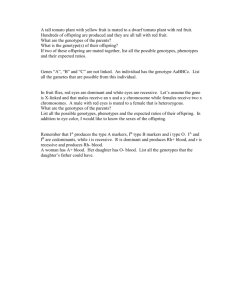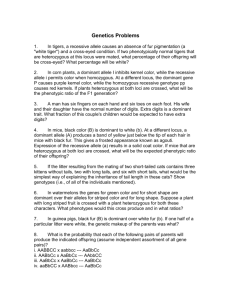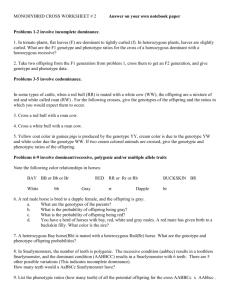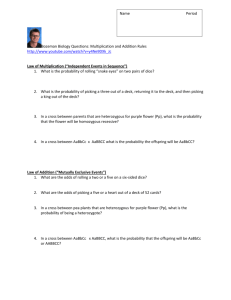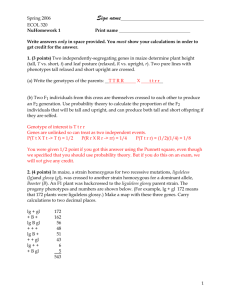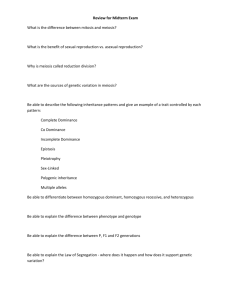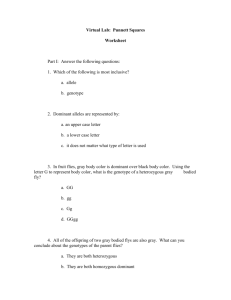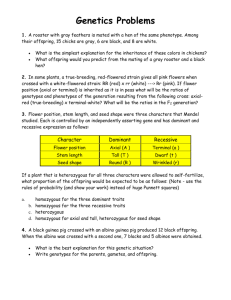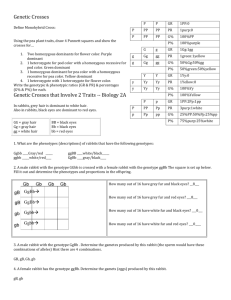HANDOUT: Genetic Prob Set #1
advertisement
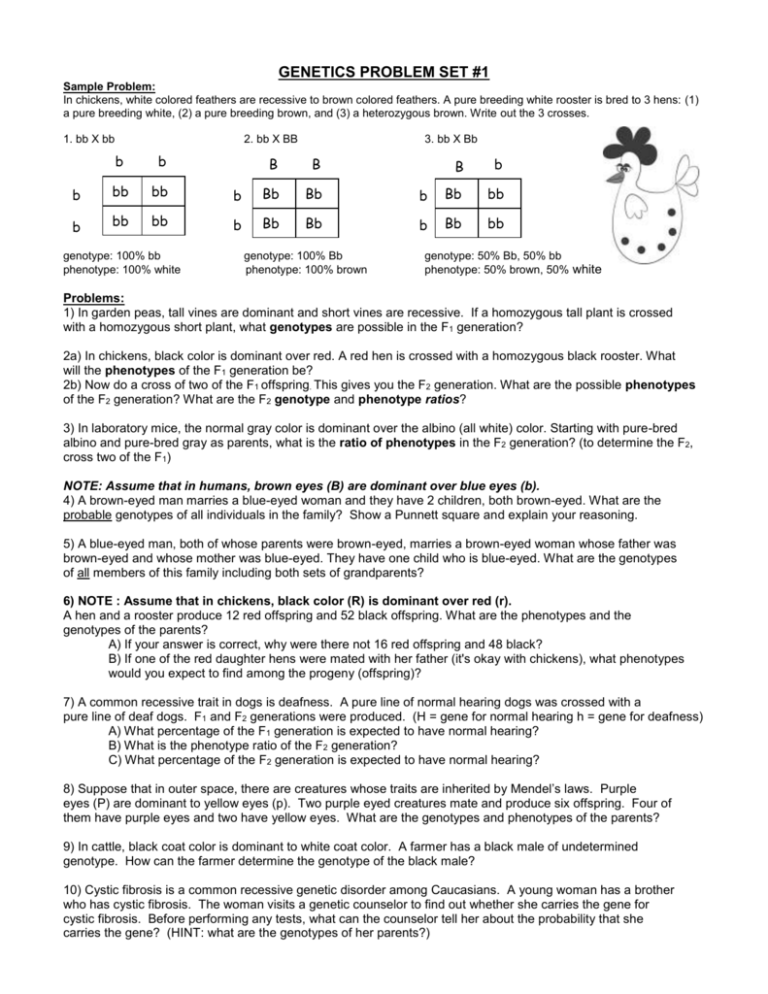
GENETICS PROBLEM SET #1 Sample Problem: In chickens, white colored feathers are recessive to brown colored feathers. A pure breeding white rooster is bred to 3 hens: (1) a pure breeding white, (2) a pure breeding brown, and (3) a heterozygous brown. Write out the 3 crosses. 1. bb X bb 2. bb X BB b b b bb bb b bb bb genotype: 100% bb phenotype: 100% white 3. bb X Bb B B b Bb Bb b Bb Bb genotype: 100% Bb phenotype: 100% brown B b b Bb bb b Bb bb genotype: 50% Bb, 50% bb phenotype: 50% brown, 50% white Problems: 1) In garden peas, tall vines are dominant and short vines are recessive. If a homozygous tall plant is crossed with a homozygous short plant, what genotypes are possible in the F1 generation? 2a) In chickens, black color is dominant over red. A red hen is crossed with a homozygous black rooster. What will the phenotypes of the F1 generation be? 2b) Now do a cross of two of the F1 offspring. This gives you the F2 generation. What are the possible phenotypes of the F2 generation? What are the F2 genotype and phenotype ratios? 3) In laboratory mice, the normal gray color is dominant over the albino (all white) color. Starting with pure-bred albino and pure-bred gray as parents, what is the ratio of phenotypes in the F2 generation? (to determine the F2, cross two of the F1) NOTE: Assume that in humans, brown eyes (B) are dominant over blue eyes (b). 4) A brown-eyed man marries a blue-eyed woman and they have 2 children, both brown-eyed. What are the probable genotypes of all individuals in the family? Show a Punnett square and explain your reasoning. 5) A blue-eyed man, both of whose parents were brown-eyed, marries a brown-eyed woman whose father was brown-eyed and whose mother was blue-eyed. They have one child who is blue-eyed. What are the genotypes of all members of this family including both sets of grandparents? 6) NOTE : Assume that in chickens, black color (R) is dominant over red (r). A hen and a rooster produce 12 red offspring and 52 black offspring. What are the phenotypes and the genotypes of the parents? A) If your answer is correct, why were there not 16 red offspring and 48 black? B) If one of the red daughter hens were mated with her father (it's okay with chickens), what phenotypes would you expect to find among the progeny (offspring)? 7) A common recessive trait in dogs is deafness. A pure line of normal hearing dogs was crossed with a pure line of deaf dogs. F1 and F2 generations were produced. (H = gene for normal hearing h = gene for deafness) A) What percentage of the F1 generation is expected to have normal hearing? B) What is the phenotype ratio of the F2 generation? C) What percentage of the F2 generation is expected to have normal hearing? 8) Suppose that in outer space, there are creatures whose traits are inherited by Mendel’s laws. Purple eyes (P) are dominant to yellow eyes (p). Two purple eyed creatures mate and produce six offspring. Four of them have purple eyes and two have yellow eyes. What are the genotypes and phenotypes of the parents? 9) In cattle, black coat color is dominant to white coat color. A farmer has a black male of undetermined genotype. How can the farmer determine the genotype of the black male? 10) Cystic fibrosis is a common recessive genetic disorder among Caucasians. A young woman has a brother who has cystic fibrosis. The woman visits a genetic counselor to find out whether she carries the gene for cystic fibrosis. Before performing any tests, what can the counselor tell her about the probability that she carries the gene? (HINT: what are the genotypes of her parents?) 11) Nearsightedness (N) is known to be dominant to normal vision (n) in humans. A man with normal vision marries a nearsighted woman who has a long family history of near sightedness. What is the probability of this couple having a nearsighted child? 12) The disease known as “PKU” (phenylketonuria) is a recessive metabolic disorder which leads to severe mental retardation. (Fortunately, if the patient is identified early, s/he can be put on a special diet lacking the amino acid phenylalanine and the brain will develop normally.) An apparently healthy couple has a baby with PKU disease. A) What are the parents’ genotypes? (Let P= healthy, and p= allele for PKU disease) B) What is the probability that their next baby will have PKU? C) What is the probability of this couple having a child who does NOT have PKU? 13) Huntington’s Disease is a human genetic disorder cause by a dominant gene (Y). It occurs in one out of 2500 people and is characterized by irregular, jerky movements, and intellectual deterioration. It usually appears during middle age, and is fatal. A man who is heterozygous for HD and a woman who is homozygous recessive decide to have children. What is the likelihood that the children have HD? Dihybrid Crosses: 14) Hearing (D) is known to be dominant to a type of deafness (d), and having healthy metabolism (P) is known to be dominant to having the disease PKU (p). A married couple, let’s call them Bella and Edward, have these phenotypes and genotypes. Bella is ddPP (deaf but normal metabolism) Edward is Ddpp (can hear but he has PKU) They ask their genetic counselor, “What is the probability of our having a “normal” child (one that can hear and does not have PKU)?” What does their counselor tell them? Please draw the dihybrid cross to help in your explanation. 15) In humans, nearsightedness (N) is dominant to normal vision (n), and polydactyly (P) (having more than 5 fingers) is dominant to 5-fingered hands (p). A man has normal vision and is heterozygous for polydactyly; a woman is heterozygous for nearsightedness and has normal hands. If they marry, what is the probability of this couple having a child with normal vision and normal hands? Draw the dihybrid cross to explain. 16) Jenny has red hair and freckles. We know that non-red hair (R) is dominant to red hair (r), and that freckles (F) are dominant to plain skin (f). She tells you that her mom has brown hair and freckles, and that her dad has red hair and plain skin. Furthermore, she says that her maternal grandmother (her mom’s mom) had red hair and plain skin. A) What is Jenny’s genotype? B) Jenny’s mom is pregnant with a second child. What is the probability that Jenny will have a brother or sister with brown hair and plain skin? Probability Problems: 17) What is the probability that each of the following pairs of parents will produce the indicated offspring? (Assume independent assortment of all gene pairs.) Parent 1 Parent 2 Offspring a. AABBCC x aabbcc AaBbCc b. AABbCc x AaBbCc AabbCC c. AaBbCc x AaBbCc AaBbCc d. aaBbCC x AABbcc AaBbCc e. AaBbCc x AaBbCc aabbcc 18) A couple, Karen and Steve, are thinking about having children. Each of them has a sibling with sickle-cell disease, a recessive condition in which the red blood cells become sickle-shaped in reduced oxygen scenarios. Neither Karen, Steve, nor any of their parents has the disease, and none of them has been tested to reveal sicklecell trait. Based on this incomplete information, calculate the probability that if this couple has a child, the child will have sickle-cell disease.
